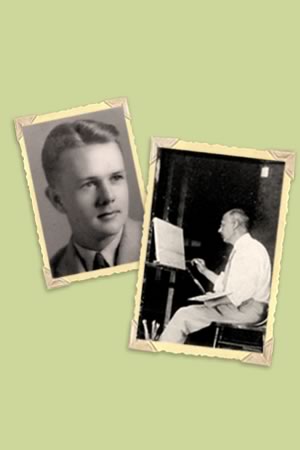Significant People
The architect for the home was RAYMOND LLEWELLEN MORRIS who was born in New Jersey on October 11, 1892. His formal schooling ended after he had completed his second year of high school. With a natural talent for drawing, he became an expert draftsman and designed submarines for the Simon Lake Torpedo Boat Company in Connecticut. In 1921 he moved to San Francisco to work for a millwork shop. While in San Francisco, Morris met Frederick Lowrey, manager of Honolulu's largest building materials company, Lewers & Cooke, and Guy Rothwell. He moved to Hawaii in 1926 and went to work for prominent architect, Charles W. Dickey, for a brief period.
Morris was astute in recognizing that there was a great need for affordable housing in Honolulu. Most of the smaller home design was left to contractors rather than architects with rather pitiful results. Morris was able to convince Frederick Lowrey to hire him as the "in-house" architect to design these small homes; Lewers & Cooke would provide the financing and the building materials. By his own estimate, Morris designed 3,000 homes, no two of which were alike.
The home was designed and built for CARL BAYER and his wife FLORENCE GURREY BAYER in 1936. Mr. Bayer's biography is published in both Men of Hawaii and The Story of Hawaii and Its Builders, a standard reference work and record of men who deservedly occupy a high place in the industrial and cultural history of the Hawaiian Islands. Born in Waldkirch, Germany in 1884 to August and Bertha Bayer, he arrived in Hawaii in 1901 after being recruited by the prominent Honolulu firm of H. Hackfeld & Company. Mr. Bayer moved to the island of Hawaii in 1908 after accepting the position of store manager for the Hutchinson Sugar Company in Naalehu, then owned by Kau Sugar Plantation. In 1910 he joined the firm of Alexander & Baldwin as manager of the store for Hawaiian Sugar Company in Makaweli, Kauai. Under the good organizational skills of Mr. Bayer, the Makaweli store became one of the largest stores of its kind. Highly dedicated to the growth and organization of business, Mr. Bayer was instrumental in the organization of the Kauai Chamber of Commerce in 1913, and served as a Director of the organization for the first two years. After moving to Oahu following his departure from Alexander & Baldwin, he became the sole proprietor of Rice Stix Dry Goods Company on Bethel Street in Honolulu.

In 1915, Carl Bayer married FLORENCE MARGUERITE GURREY, daughter of renowned local artist Alfred Gurrey, and they had one son, Walter Gurrey Bayer. Their desire to provide their son with the best possible education led the Bayers to move to Honolulu where Walter could attend Lincoln School and then Punahou School. Florence Gurrey Bayer was an expert horsewoman and a champion of animal rights, serving as a Secretary for the Hawaiian Humane Society. She, with Lucy Ward (another prominent member of society) was instrumental in forming the Society as a group of people interested in protecting the dray horses of Manoa quarry from abuse by their drivers.
Her father was ALFRED RICHARD GURREY, SR., an insurance adjuster and secretary of the Board of Fire Underwriters of the Territory of Hawaii. Although Mr. Gurrey lacked any formal art training, he was a member of the Pallet Club of San Francisco and was elected to the Kilohana Art League and exhibited in their exhibitions from 1900 to 1907. Many of his paintings depicted ocean scenes due to his love of the ocean and sailing. Mr. Gurrey was one of the early members of the elite local organization, Outrigger Canoe Club, and was Commodore of the Corinthian Yacht Club of San Francisco prior to his moving to Hawaii. Florence Bayer hung many of her father's paintings depicting marine vistas in her Aina Haina home. In 1996, Walter Bayer donated 30 of his grandfather's paintings to the Kauai Museum in Lihue, which have been featured in exhibitions at the museum.